Internal Control: Assessment 2 Report - Finance, Semester 1
VerifiedAdded on 2020/07/23
|6
|1409
|62
Report
AI Summary
This report provides an in-depth analysis of internal control mechanisms, focusing on the identification and assessment of breaches within an organization. It begins by outlining the importance of internal control programs in ensuring operational efficiency and financial stability, emphasizing the need for policies and procedures to safeguard assets and maintain reliable financial data. The report details a specific case of internal control breach, highlighting the carelessness of auditors and the fraudulent activities of a section manager and his wife. It then explores the five key components of an internal control program: control environment, risk assessment, control activities, information and communication, and monitoring. Furthermore, the report suggests various modification techniques to improve internal control, such as analyzing inadequate records, establishing key business cycles, and strengthening physical and logical security. The conclusion reinforces the significance of internal control in preventing financial data manipulation and ensuring ethical conduct by professionals. Finally, the report includes references to relevant books, journals, and online resources.
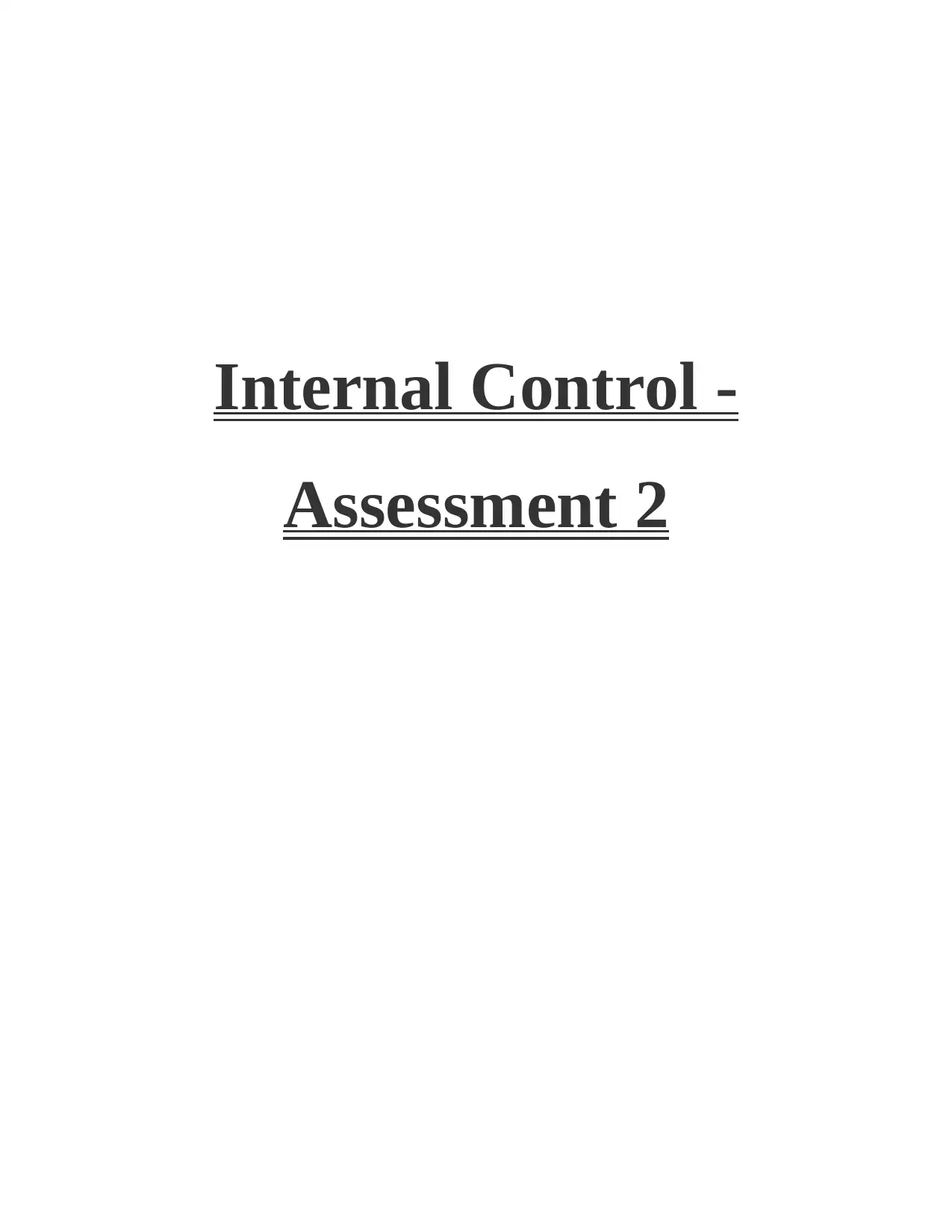
Internal Control -
Assessment 2
Assessment 2
Paraphrase This Document
Need a fresh take? Get an instant paraphrase of this document with our AI Paraphraser
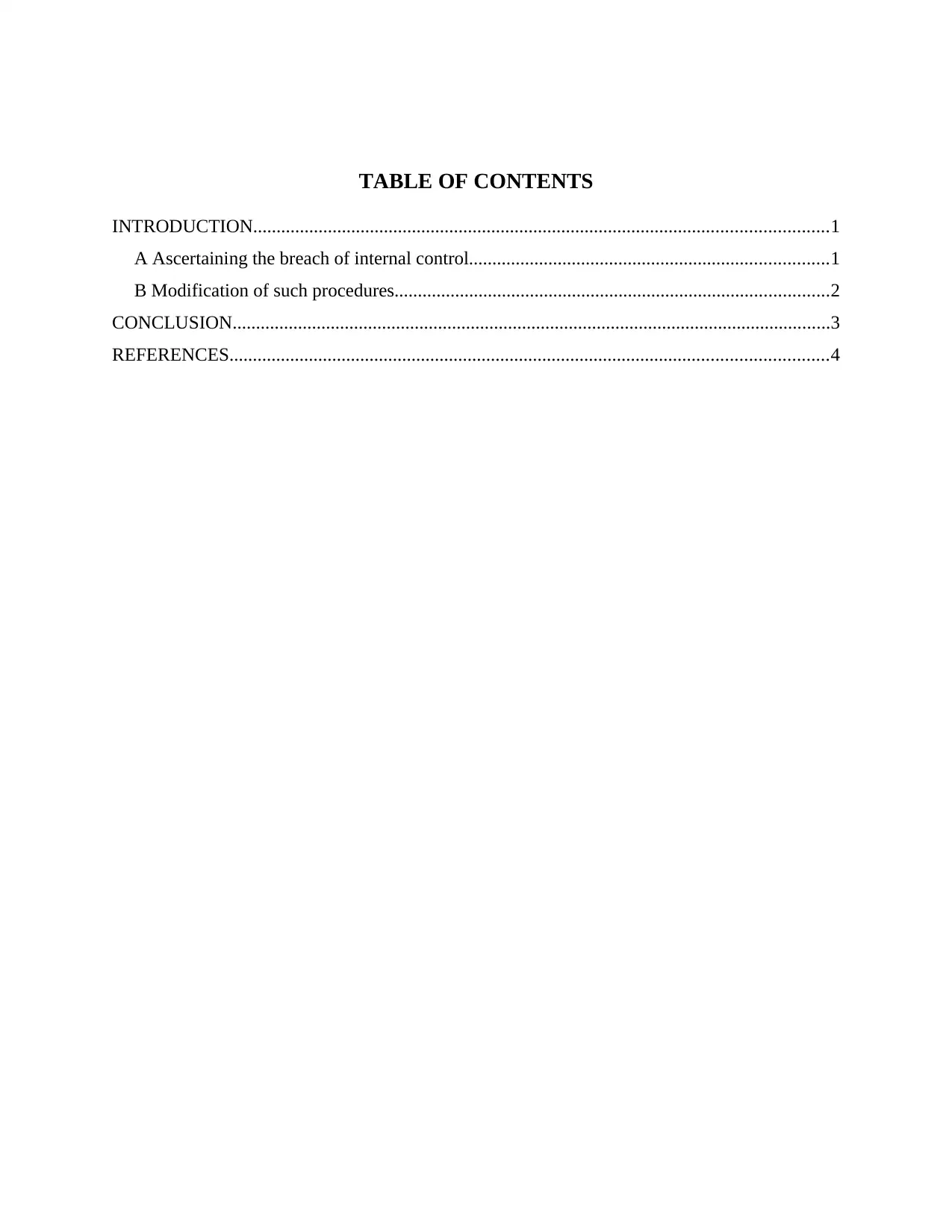
TABLE OF CONTENTS
INTRODUCTION...........................................................................................................................1
A Ascertaining the breach of internal control.............................................................................1
B Modification of such procedures.............................................................................................2
CONCLUSION................................................................................................................................3
REFERENCES................................................................................................................................4
INTRODUCTION...........................................................................................................................1
A Ascertaining the breach of internal control.............................................................................1
B Modification of such procedures.............................................................................................2
CONCLUSION................................................................................................................................3
REFERENCES................................................................................................................................4
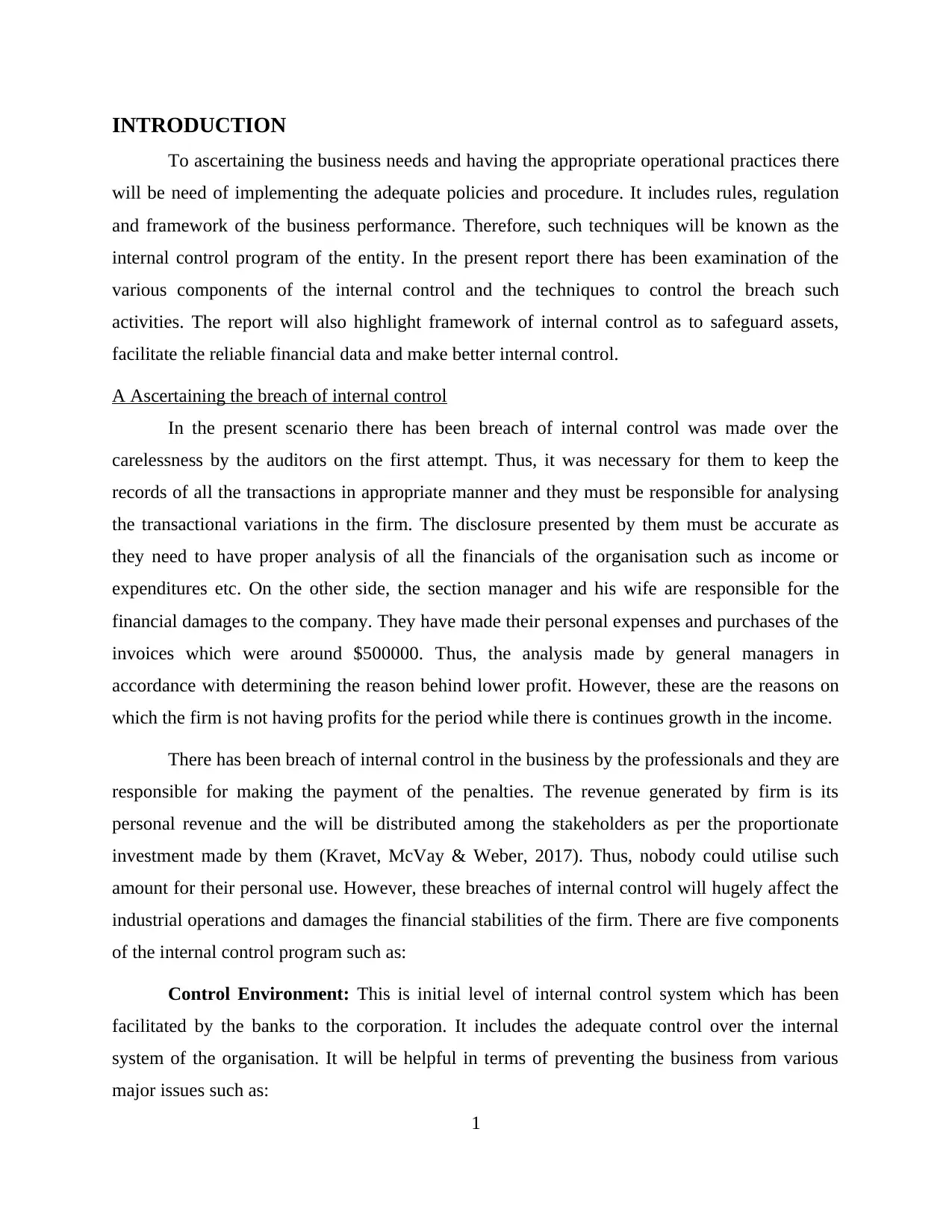
INTRODUCTION
To ascertaining the business needs and having the appropriate operational practices there
will be need of implementing the adequate policies and procedure. It includes rules, regulation
and framework of the business performance. Therefore, such techniques will be known as the
internal control program of the entity. In the present report there has been examination of the
various components of the internal control and the techniques to control the breach such
activities. The report will also highlight framework of internal control as to safeguard assets,
facilitate the reliable financial data and make better internal control.
A Ascertaining the breach of internal control
In the present scenario there has been breach of internal control was made over the
carelessness by the auditors on the first attempt. Thus, it was necessary for them to keep the
records of all the transactions in appropriate manner and they must be responsible for analysing
the transactional variations in the firm. The disclosure presented by them must be accurate as
they need to have proper analysis of all the financials of the organisation such as income or
expenditures etc. On the other side, the section manager and his wife are responsible for the
financial damages to the company. They have made their personal expenses and purchases of the
invoices which were around $500000. Thus, the analysis made by general managers in
accordance with determining the reason behind lower profit. However, these are the reasons on
which the firm is not having profits for the period while there is continues growth in the income.
There has been breach of internal control in the business by the professionals and they are
responsible for making the payment of the penalties. The revenue generated by firm is its
personal revenue and the will be distributed among the stakeholders as per the proportionate
investment made by them (Kravet, McVay & Weber, 2017). Thus, nobody could utilise such
amount for their personal use. However, these breaches of internal control will hugely affect the
industrial operations and damages the financial stabilities of the firm. There are five components
of the internal control program such as:
Control Environment: This is initial level of internal control system which has been
facilitated by the banks to the corporation. It includes the adequate control over the internal
system of the organisation. It will be helpful in terms of preventing the business from various
major issues such as:
1
To ascertaining the business needs and having the appropriate operational practices there
will be need of implementing the adequate policies and procedure. It includes rules, regulation
and framework of the business performance. Therefore, such techniques will be known as the
internal control program of the entity. In the present report there has been examination of the
various components of the internal control and the techniques to control the breach such
activities. The report will also highlight framework of internal control as to safeguard assets,
facilitate the reliable financial data and make better internal control.
A Ascertaining the breach of internal control
In the present scenario there has been breach of internal control was made over the
carelessness by the auditors on the first attempt. Thus, it was necessary for them to keep the
records of all the transactions in appropriate manner and they must be responsible for analysing
the transactional variations in the firm. The disclosure presented by them must be accurate as
they need to have proper analysis of all the financials of the organisation such as income or
expenditures etc. On the other side, the section manager and his wife are responsible for the
financial damages to the company. They have made their personal expenses and purchases of the
invoices which were around $500000. Thus, the analysis made by general managers in
accordance with determining the reason behind lower profit. However, these are the reasons on
which the firm is not having profits for the period while there is continues growth in the income.
There has been breach of internal control in the business by the professionals and they are
responsible for making the payment of the penalties. The revenue generated by firm is its
personal revenue and the will be distributed among the stakeholders as per the proportionate
investment made by them (Kravet, McVay & Weber, 2017). Thus, nobody could utilise such
amount for their personal use. However, these breaches of internal control will hugely affect the
industrial operations and damages the financial stabilities of the firm. There are five components
of the internal control program such as:
Control Environment: This is initial level of internal control system which has been
facilitated by the banks to the corporation. It includes the adequate control over the internal
system of the organisation. It will be helpful in terms of preventing the business from various
major issues such as:
1
⊘ This is a preview!⊘
Do you want full access?
Subscribe today to unlock all pages.

Trusted by 1+ million students worldwide
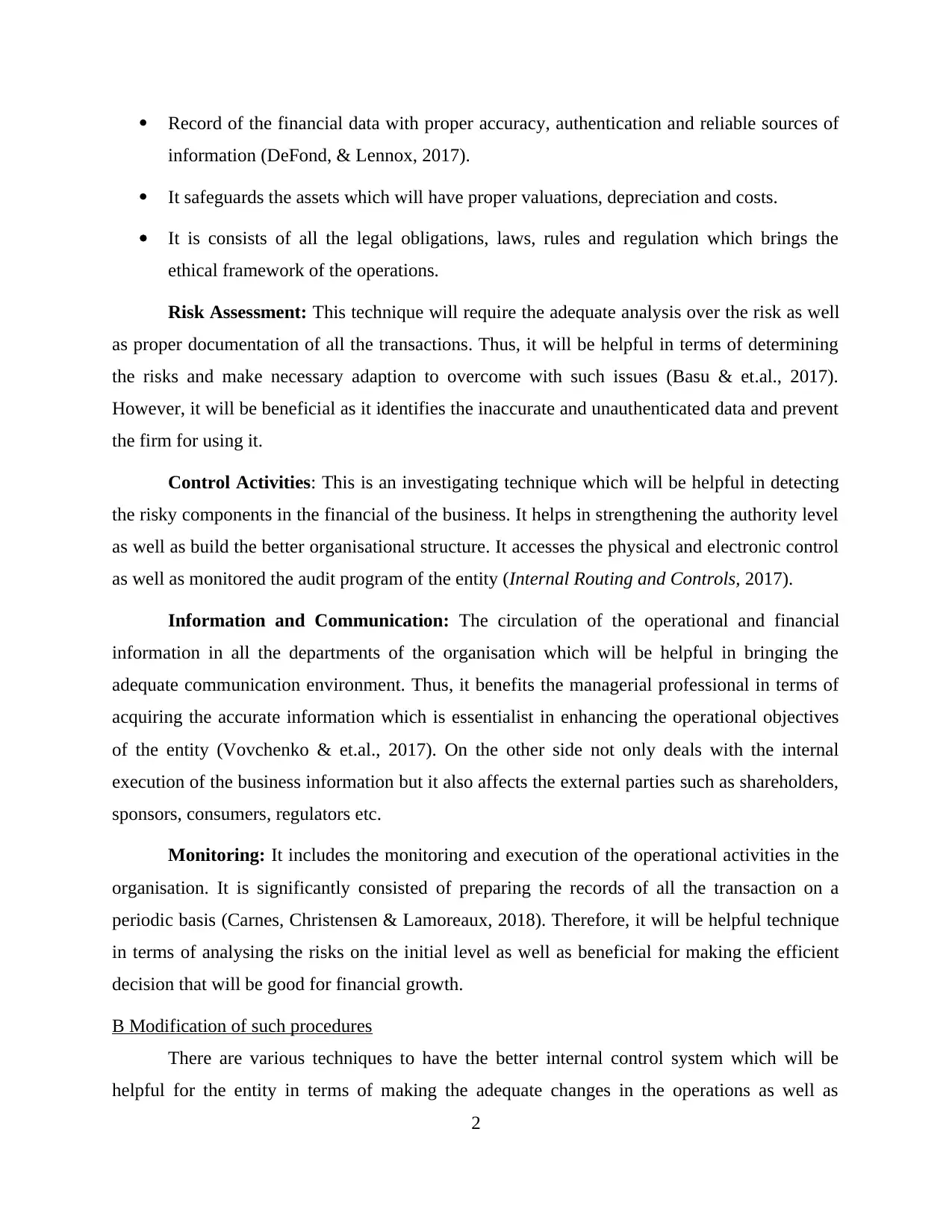
Record of the financial data with proper accuracy, authentication and reliable sources of
information (DeFond, & Lennox, 2017).
It safeguards the assets which will have proper valuations, depreciation and costs.
It is consists of all the legal obligations, laws, rules and regulation which brings the
ethical framework of the operations.
Risk Assessment: This technique will require the adequate analysis over the risk as well
as proper documentation of all the transactions. Thus, it will be helpful in terms of determining
the risks and make necessary adaption to overcome with such issues (Basu & et.al., 2017).
However, it will be beneficial as it identifies the inaccurate and unauthenticated data and prevent
the firm for using it.
Control Activities: This is an investigating technique which will be helpful in detecting
the risky components in the financial of the business. It helps in strengthening the authority level
as well as build the better organisational structure. It accesses the physical and electronic control
as well as monitored the audit program of the entity (Internal Routing and Controls, 2017).
Information and Communication: The circulation of the operational and financial
information in all the departments of the organisation which will be helpful in bringing the
adequate communication environment. Thus, it benefits the managerial professional in terms of
acquiring the accurate information which is essentialist in enhancing the operational objectives
of the entity (Vovchenko & et.al., 2017). On the other side not only deals with the internal
execution of the business information but it also affects the external parties such as shareholders,
sponsors, consumers, regulators etc.
Monitoring: It includes the monitoring and execution of the operational activities in the
organisation. It is significantly consisted of preparing the records of all the transaction on a
periodic basis (Carnes, Christensen & Lamoreaux, 2018). Therefore, it will be helpful technique
in terms of analysing the risks on the initial level as well as beneficial for making the efficient
decision that will be good for financial growth.
B Modification of such procedures
There are various techniques to have the better internal control system which will be
helpful for the entity in terms of making the adequate changes in the operations as well as
2
information (DeFond, & Lennox, 2017).
It safeguards the assets which will have proper valuations, depreciation and costs.
It is consists of all the legal obligations, laws, rules and regulation which brings the
ethical framework of the operations.
Risk Assessment: This technique will require the adequate analysis over the risk as well
as proper documentation of all the transactions. Thus, it will be helpful in terms of determining
the risks and make necessary adaption to overcome with such issues (Basu & et.al., 2017).
However, it will be beneficial as it identifies the inaccurate and unauthenticated data and prevent
the firm for using it.
Control Activities: This is an investigating technique which will be helpful in detecting
the risky components in the financial of the business. It helps in strengthening the authority level
as well as build the better organisational structure. It accesses the physical and electronic control
as well as monitored the audit program of the entity (Internal Routing and Controls, 2017).
Information and Communication: The circulation of the operational and financial
information in all the departments of the organisation which will be helpful in bringing the
adequate communication environment. Thus, it benefits the managerial professional in terms of
acquiring the accurate information which is essentialist in enhancing the operational objectives
of the entity (Vovchenko & et.al., 2017). On the other side not only deals with the internal
execution of the business information but it also affects the external parties such as shareholders,
sponsors, consumers, regulators etc.
Monitoring: It includes the monitoring and execution of the operational activities in the
organisation. It is significantly consisted of preparing the records of all the transaction on a
periodic basis (Carnes, Christensen & Lamoreaux, 2018). Therefore, it will be helpful technique
in terms of analysing the risks on the initial level as well as beneficial for making the efficient
decision that will be good for financial growth.
B Modification of such procedures
There are various techniques to have the better internal control system which will be
helpful for the entity in terms of making the adequate changes in the operations as well as
2
Paraphrase This Document
Need a fresh take? Get an instant paraphrase of this document with our AI Paraphraser
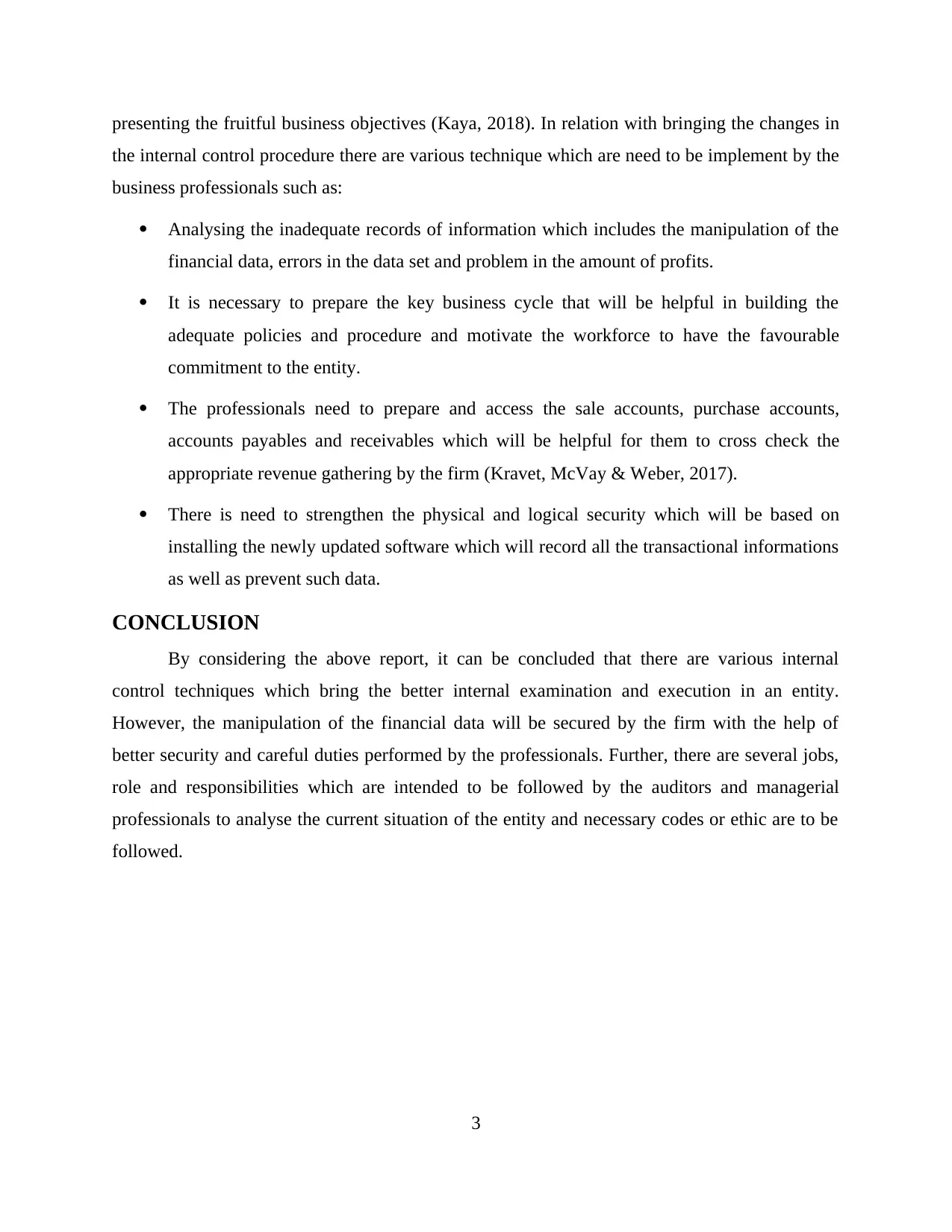
presenting the fruitful business objectives (Kaya, 2018). In relation with bringing the changes in
the internal control procedure there are various technique which are need to be implement by the
business professionals such as:
Analysing the inadequate records of information which includes the manipulation of the
financial data, errors in the data set and problem in the amount of profits.
It is necessary to prepare the key business cycle that will be helpful in building the
adequate policies and procedure and motivate the workforce to have the favourable
commitment to the entity.
The professionals need to prepare and access the sale accounts, purchase accounts,
accounts payables and receivables which will be helpful for them to cross check the
appropriate revenue gathering by the firm (Kravet, McVay & Weber, 2017).
There is need to strengthen the physical and logical security which will be based on
installing the newly updated software which will record all the transactional informations
as well as prevent such data.
CONCLUSION
By considering the above report, it can be concluded that there are various internal
control techniques which bring the better internal examination and execution in an entity.
However, the manipulation of the financial data will be secured by the firm with the help of
better security and careful duties performed by the professionals. Further, there are several jobs,
role and responsibilities which are intended to be followed by the auditors and managerial
professionals to analyse the current situation of the entity and necessary codes or ethic are to be
followed.
3
the internal control procedure there are various technique which are need to be implement by the
business professionals such as:
Analysing the inadequate records of information which includes the manipulation of the
financial data, errors in the data set and problem in the amount of profits.
It is necessary to prepare the key business cycle that will be helpful in building the
adequate policies and procedure and motivate the workforce to have the favourable
commitment to the entity.
The professionals need to prepare and access the sale accounts, purchase accounts,
accounts payables and receivables which will be helpful for them to cross check the
appropriate revenue gathering by the firm (Kravet, McVay & Weber, 2017).
There is need to strengthen the physical and logical security which will be based on
installing the newly updated software which will record all the transactional informations
as well as prevent such data.
CONCLUSION
By considering the above report, it can be concluded that there are various internal
control techniques which bring the better internal examination and execution in an entity.
However, the manipulation of the financial data will be secured by the firm with the help of
better security and careful duties performed by the professionals. Further, there are several jobs,
role and responsibilities which are intended to be followed by the auditors and managerial
professionals to analyse the current situation of the entity and necessary codes or ethic are to be
followed.
3
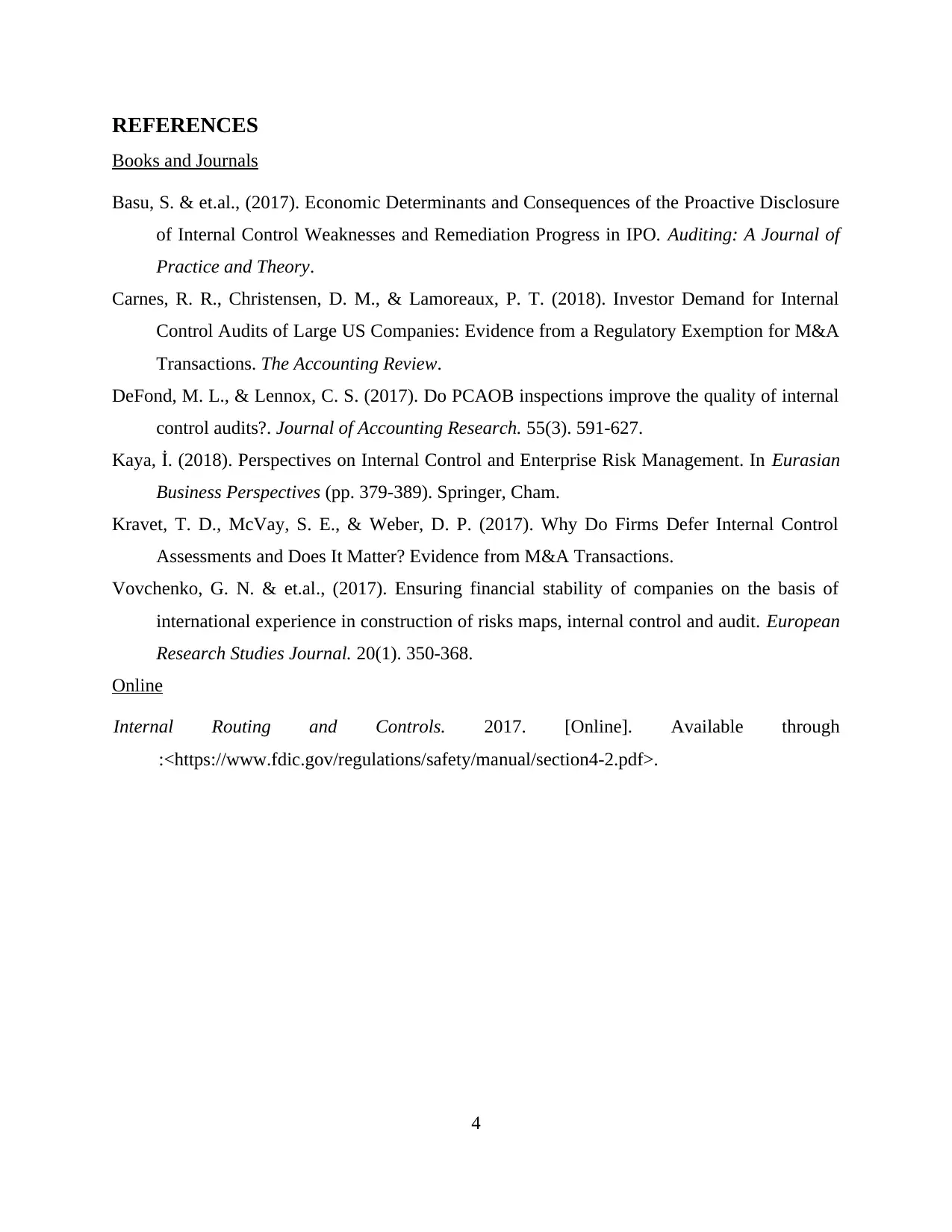
REFERENCES
Books and Journals
Basu, S. & et.al., (2017). Economic Determinants and Consequences of the Proactive Disclosure
of Internal Control Weaknesses and Remediation Progress in IPO. Auditing: A Journal of
Practice and Theory.
Carnes, R. R., Christensen, D. M., & Lamoreaux, P. T. (2018). Investor Demand for Internal
Control Audits of Large US Companies: Evidence from a Regulatory Exemption for M&A
Transactions. The Accounting Review.
DeFond, M. L., & Lennox, C. S. (2017). Do PCAOB inspections improve the quality of internal
control audits?. Journal of Accounting Research. 55(3). 591-627.
Kaya, İ. (2018). Perspectives on Internal Control and Enterprise Risk Management. In Eurasian
Business Perspectives (pp. 379-389). Springer, Cham.
Kravet, T. D., McVay, S. E., & Weber, D. P. (2017). Why Do Firms Defer Internal Control
Assessments and Does It Matter? Evidence from M&A Transactions.
Vovchenko, G. N. & et.al., (2017). Ensuring financial stability of companies on the basis of
international experience in construction of risks maps, internal control and audit. European
Research Studies Journal. 20(1). 350-368.
Online
Internal Routing and Controls. 2017. [Online]. Available through
:<https://www.fdic.gov/regulations/safety/manual/section4-2.pdf>.
4
Books and Journals
Basu, S. & et.al., (2017). Economic Determinants and Consequences of the Proactive Disclosure
of Internal Control Weaknesses and Remediation Progress in IPO. Auditing: A Journal of
Practice and Theory.
Carnes, R. R., Christensen, D. M., & Lamoreaux, P. T. (2018). Investor Demand for Internal
Control Audits of Large US Companies: Evidence from a Regulatory Exemption for M&A
Transactions. The Accounting Review.
DeFond, M. L., & Lennox, C. S. (2017). Do PCAOB inspections improve the quality of internal
control audits?. Journal of Accounting Research. 55(3). 591-627.
Kaya, İ. (2018). Perspectives on Internal Control and Enterprise Risk Management. In Eurasian
Business Perspectives (pp. 379-389). Springer, Cham.
Kravet, T. D., McVay, S. E., & Weber, D. P. (2017). Why Do Firms Defer Internal Control
Assessments and Does It Matter? Evidence from M&A Transactions.
Vovchenko, G. N. & et.al., (2017). Ensuring financial stability of companies on the basis of
international experience in construction of risks maps, internal control and audit. European
Research Studies Journal. 20(1). 350-368.
Online
Internal Routing and Controls. 2017. [Online]. Available through
:<https://www.fdic.gov/regulations/safety/manual/section4-2.pdf>.
4
⊘ This is a preview!⊘
Do you want full access?
Subscribe today to unlock all pages.

Trusted by 1+ million students worldwide
1 out of 6
Related Documents
Your All-in-One AI-Powered Toolkit for Academic Success.
+13062052269
info@desklib.com
Available 24*7 on WhatsApp / Email
![[object Object]](/_next/static/media/star-bottom.7253800d.svg)
Unlock your academic potential
Copyright © 2020–2025 A2Z Services. All Rights Reserved. Developed and managed by ZUCOL.





